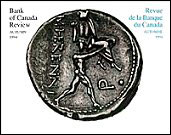Bank of Canada Review - Autumn 1994
Cover page
Roman Republic: Denarius, 108–107 BC
To the left of the figure is the name of the moneyer M. Herenni (Marcus Herennius), and to the right is the control mark, a horizontal P and dot. About the size of a 10-cent piece, this denarius is part of the National Currency Collection, Bank of Canada.
Photography by James Zagon.
